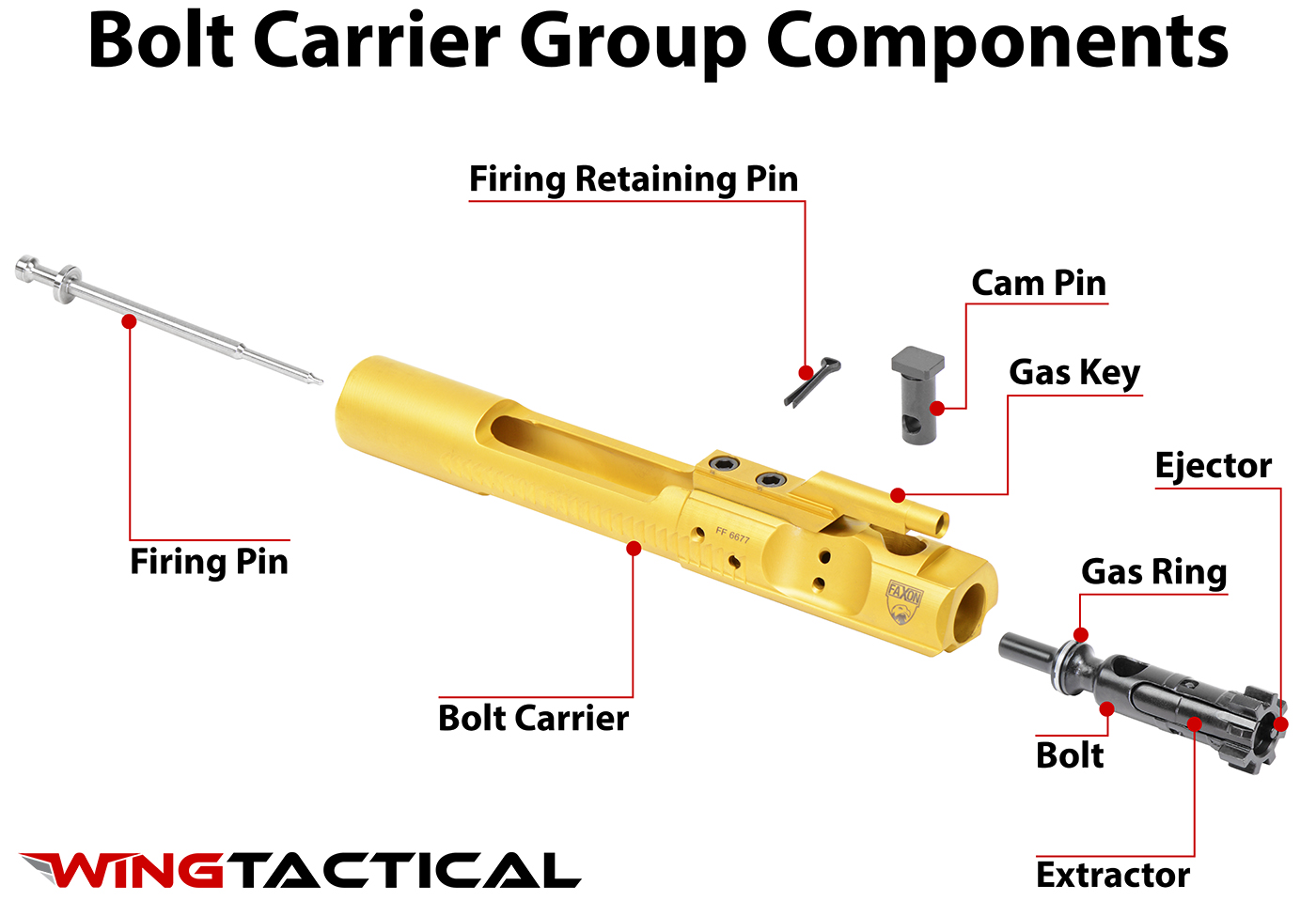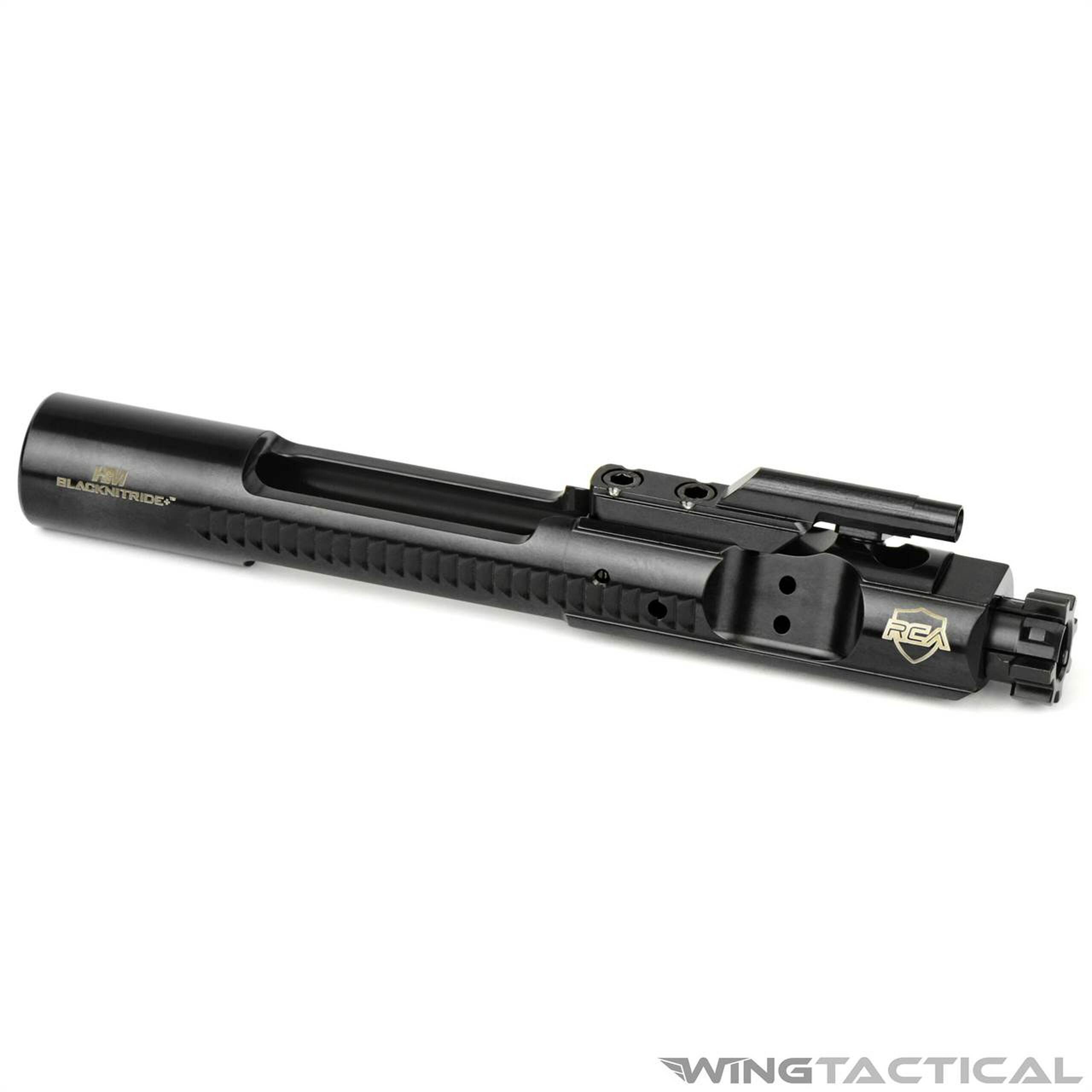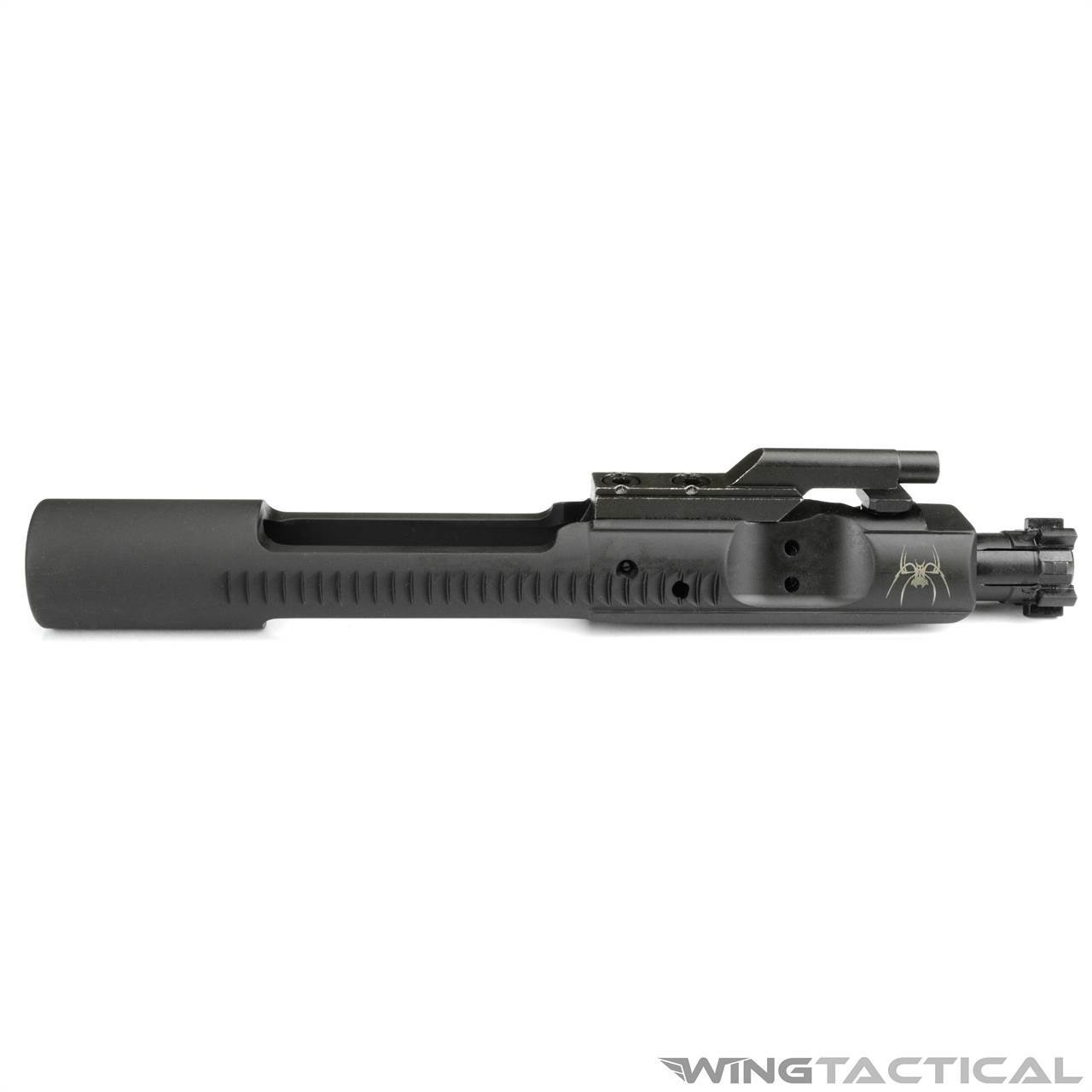
AR-15s are some of the most capable and reliable rifles, and militaries and law enforcement use them in the U.S. and all over the world. Though every part of the rifle contributes to its reliability and effectiveness, one of the most important ones is the bolt carrier group (BCG).
If you are building an AR-15, you will find several bolt carrier group options in the market, with different features and profiles. Many terms are thrown around in the firearm community while talking about BCGs,like “Full Auto, M16 BCG, and staked gas keys.” What do they all mean? Well, in this post, we will tell you everything you need to know about the AR-15's best bolt carrier groups.
PARTS OF A BOLT CARRIER GROUP
The AR-15 is a semi-automatic rifle, and to achieve semi-auto fire in rapid succession, the best AR-15 bolt carrier groups need to perform many actions; multiple components must work together to make the rifle cycle. So, let's break down each bolt carrier group component and what it does.

BOLT
The bolt carrier groups use a rotating bolt design. The bolt has a "star" at the front, shaped like a cog with seven locking lugs. The bolt rotates approximately 15 degrees in the camber and locks using the locking lugs for a secure discharge of the bullet.
Once the bullet is fired, the extractor, which hooks the rim of each cartridge when it is chambered, pulls the fired casing out of the chamber, and at the same time, the spring-loaded ejector inside the bolt head pushes the fired case out of the chamber through the ejection port.
The bolt then moves back to the buffer tube, and with the pressure of the buffer tube spring, it comes back forward, picking up a round from the magazine and completing the cycle again.
The gas ring is another very important part of the AR-15 bolt carrier groups. It traps the expanding cases so that they can operate the bolt instead of being dispersed inside the upper receiver.
CARRIER
The bolt carrier is the main part of the best kinds of bolt carrier groups, which houses all the other components so that they can operate smoothly with each other. Moreover, it makes contact with the buffer and the buffer tube spring and also adds weight to the BCG. The Bolt Carrier absorbs most of the force generated by the expanding gasses in the chamber. Therefore, it has to be made from forged steel to handle the pressure and heat.
GAS KEY
The Gas key is located on top of the bolt carrier. It is in line with the gas tube and takes the impact of the gasses returning from the gas tube. The gas key is hollow and passes the gas to the body of the bolt, which forces the bolt to rotate, unlock, and cycle so that the rifle can fire in succession. Always check the quality of a gas key when looking for the best bolt carrier group to purchase.
FIRING PIN
In the AR-15 bolt carrier groups, the firing pin is the part that strikes the primer on the cartridge and sets it off. It rests in the bolt, and its head barely protrudes from the front of the bolt. When the trigger is pulled, the hammer is released. It strikes the back of the firing pin, and a free-floating pin strikes the primer to ignite it.
Now, the pin has to be free-floating to move when the hammer strikes it. However, a small retaining pin is also inserted from the side to prevent it from falling out of the bolt.
CAM PIN
The cam pin is another very important part of the types of bolt carrier groups. It keeps the bolt from over-rotating when it is unlocked under the pressure of the gases. The cam pin rides in a cutout atop the carrier and has a hole in the middle as well for the firing pin to slide through. This keeps the cam pin in the proper orientation and allows the firing pin, bolt, and cam pin to move as a single unit.
BOLT CARRIER GROUP TYPES / PROFILES
M16 BCG (A.K.A. FULL-AUTO)

The M16 or modern M4 are military designations for the AR-15 rifle, and unlike commercial AR-15s, they are able to fire in fully automatic mode. To allow the M16 and M4 to fire in full auto, the bolt needs to have an extra piece of metal in the rear, so that it can trip the auto sear, which allows the hammer to continuously strike the firing pin and keep the rifle cycling until the trigger is pressed.
Now, it is important to know that using an M16 BCG won't make your rifle fully automatic. You need a different trigger mechanism, hammer, safety selector lever, and an auto sear to make your rifle fire in full auto. Therefore, it is completely legal to use the M16 full-auto bolt carrier group in your civilian semi-auto AR-15.
Some people opt to use an M16 BCG because it cycles more reliably than a standard AR-15 BCG because of the extra weight, which can result in a slightly lower cyclic rate as well.
AR-15 BCG (A.K.A. SEMI-AUTO)
Many people think the AR-15 is the best bolt carrier group because it is lighter since it doesn't have the extra metal in the rear to engage the auto sear. It is only capable of semi-auto fire. However, this bolt profile isn't that popular, because it does not decrease the weight enough to have any significant advantage. These days, most people either opt for standard M16 profile BCGs or Low Mass BCGs.
LOW MASS BCG
Low-mass bolt carrier groups are considered the best bold carrier groups among competition shooters and people who want a fast-shooting rifle. These lightweight bolt carrier groups are usually fluted and/or with weight reduction cutouts.
They can make your rifle lighter, especially when you use other lightweight parts with it, and they can also decrease recoil and increase the cyclic rate of your rifle. Bear in mind, though, that you might have to use a lighter buffer and buffer tube spring so that it can be depressed properly by the light BCG. In addition, you will probably need to install an adjustable gas block to ensure the rifle is not over-gassed, which can increase perceived recoil and damage your BCG.
BOLT CARRIER GROUP MATERIALS

Typically, bolt carrier groups are made from durable steel that can withstand the high pressures and heat in the chamber after a round is fired. These are materials commonly used to make components in the bolt carrier group.
BOLT: CARPENTER 158
Carpenter No. 158 steel is a proprietary type of steel developed for the U.S. Military by a company called Carpenter Technology. It is also used to make M4 and M16 bolts and AR-15 bolts, especially by many big-name brands. This case-hardened steel has a very hard exterior, which prevents surface wear and cracking, whereas the inside steel is slightly softer and, therefore, more flexible, which allows for better absorption of forces and a lower chance of stress fractures and deformation. This is considered to be one of the materials used to make the best bolt.
CARRIER: 8620 STEEL
8620 steel is not as strong as Carpenter 158 steel, and therefore, it is only used for manufacturing bolt carriers. Mil-Spec M4 and M16 rifles use 8620 steel for their bolt carriers, which also helps in keeping the weight of the BCG down.
OTHERS MATERIALS
Though Carpenter 158 and 8620 steel are used for making Mil-Spec AR-15s, M4s, and M16s, many commercial manufacturers also use other materials. For instance, Faxon Firearms uses 9310 Steel bolts for their BCG, and V Seven Weapon System offers a bolt carrier in Grade 5 Titanium. These materials are stronger than Mil-Spec steel and are more readily available, leading some to believe they are the ultimate materials for the best Mil-Spec profile bolt carrier groups.
Some companies also use high-strength aluminum to make their bolt carriers, which are very light and ideal for a lightweight race gun. J.P. Enterprises use aluminum for their Ultra Low Mass Bolt Carrier Group
COMMON BCG FINISHES
PARKERIZED
Most Mil-Spec bolt carrier groups, on M4 and M16s, have a Parkerized finish. This finish is achieved by applying a chemical phosphate conversion coating to the steel, and it can increase resistance to wear and protect the bolt's surface from Corrosion. A Parkerized finish is the market's most affordable bolt carrier group finish.
BLACK NITRIDE
Heat rating is used to achieve a black nitride finish, as nitrogen is diffused into the BCG steel's surface, making it case-hardened. BCGs with a black nitride finish are extremely wear and corrosion-resistant, and they also have a smoother surface, which allows the bolt to cycle more smoothly.
NICKEL BORON

A Nickel Boron finish offers better wear and corrosion resistance than both Parkerized and Nitrate finishes. It also has a very low coefficient of friction resulting in ultra-smooth operation and ease of cleaning. Hence, it is a very popular finish for the high quality AR-15 BCGs.
OTHER ADVANCED COATINGS
DIAMOND-LIKE CARBON
Diamond-like carbon, or as it is also known, DLC coating in a modern metal finish, is applied on metal through a Physical Vapor Deposition (PVD) process. It makes the molt steel very strong and highly corrosion-resistant. In addition, the finish is virtually scratchproof and won't crack or peel. Moreover, it gives your BCG a striking dark gray finish.
TITANIUM NITRIDE
Titanium Nitride is a super-strong ceramic material that gives your BCG a unique gold appearance. It is also solid and improves your BCG's lubricity, corrosion resistance, and edge retention.
TESTINGS AND FEATURES
HIGH-PRESSURE TESTING (HPT)
High-pressure testing ensures that the bolt can handle high chamber pressures and keep firing without any risk of failure. In this test, the BCG is used to fire with a high-pressure cartridge well over the SAMMI specifications. The bolt is then MPI tested to ensure the high-pressure round didn't damage the steel.
MAGNETIC PARTICLE INSPECTED (MPI)
This is a standard quality testing process for high-quality bolt carrier groups, which allows the manufacturer to ensure there aren't any microscopic cracks in the surface of the BCG. The BCG to be tested is placed in a magnetic field, and a liquid solution containing magnetic particles is applied to its surface. If there are any cracks or imperfections in the surface of the BCG, the magnetic particles stick to them. Ultraviolet light is then used to illuminate the imperfections, making them visible. So, bolts that are MPI tested have lower chances of surface cracks and damage.
SHOT PEENED
Shot peening is a process used to make metals more stress-resistant. It is commonly used in engine pistons. However, it can also be used to make bolt carrier groups for an AR-15 more durable and long-lasting.
PROPERLY STAKED GAS KEY
The gas key is an important part of the AR-15 bolt carrier group, and it takes the full impact of the gasses returning from the gas tube. Therefore, it needs to be appropriately fit into the BCG. Normally, two screws are used to mount the gas key on the bolt carrier. In a properly staked gas key, the metal on the sides of the screws is bent and staked into the screws to prevent them from backing out.
CONCLUSION
So, if you are getting into an AR building, knowing all these details about bolt carrier groups is very important. They are easily one of the most important parts of any rifle, and after reading this post, you will probably be able to find the best BCG for your next AR build.
Browse our selection of quality AR-15 BCGs today or get in touch with our team to learn more about which BCG is best for your build.